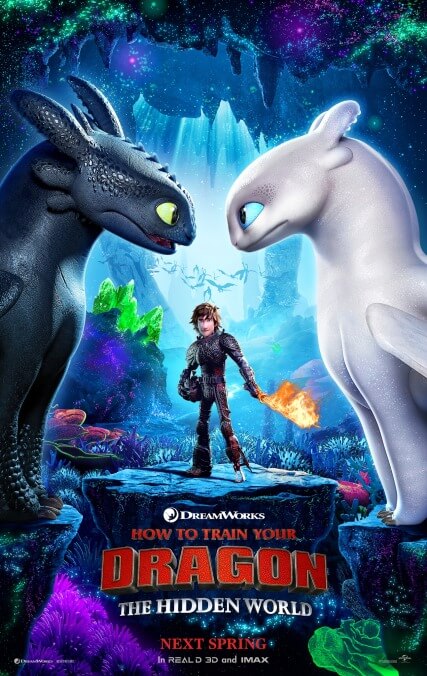Most big-studio, big-budget animated movies are, if nothing else, dazzling technical achievements. What’s frustrating is how indifferently written so many of them are, to the point where you end up feeling bad for the animators, painstakingly rendering every strand of hair and blade of grass, all in service of some very first-draft magic. The Hidden World, the third but probably-not-final-if-this-one-makes-a-mint entry in the How To Train Your Dragon series, is about as breathlessly gorgeous as its predecessors. Early on, the “camera” swoops around the spiky topography of a North Sea island paradise, and your eyes practically burst, trying to take in the full menagerie of colorful, eponymous beasties packed into every frame. Later, to top that rainbow spectacle, we’re taken on a tour of a lost kingdom that’s like a dry-land tropical reef, illuminated by the almost heavenly glow of its flora and fauna. The Hidden World doesn’t really stop giving you lovely things to gawk at. But as an act of storytelling, it’s curiously perfunctory, never rising to the level of effort and care put into creating its cornucopia of visual pleasures.
That wasn’t a problem with the original How To Train Your Dragon, which adapted Cressida Cowell’s children’s lit bestseller into a soulfully simple fable about the interspecies friendship that develops between a pacifistic teen Viking and his jet-black, fire-breathing exotic pet. It remains the closest DreamWorks Animation has come to reaching the heights of classic Disney or Pixar enchantment. But the 2014 sequel misplaced some of that charm, cluttering things up with extraneous new characters while basically just recycling the first film’s be-yourself messaging. In part three, we return once more to the island of Berk, home of gruff, bearded warriors and their scaly companions. The Vikings have adjusted so fully to the company of dragons that they don’t even seem to regard their one-time natural enemies with wonder anymore—they’re just a part of everyday life. Unfortunately, the movie itself adopts that same casual perspective on its main attractions. It figures we all get why dragons are cool and special, and that it doesn’t need to make the case anew.
One year after the events of the second movie, Hiccup (Jay Baruchel), who’s taken up his late father’s mantle as chief of the tribe, dreams of relocation, of abandoning the ancestral homeland for greener pastures: the fabled hidden world of the title, which appears on no map but is said to be situated somewhere to the west, tucked behind a waterfall. Rescuing and basically domesticating dragons has certainly put Berk on the map—and among those itching for a fight is Grimmel, a legendary big game hunter with his sights set on Hiccup’s winged bestie, Toothless. Going above and beyond for a sound-booth paycheck gig, F. Murray Abraham voices the villain with a surplus of delicious haughtiness. But there’s really not much dimension to the guy, even for the heavy of a family film. (His motivation: He hates dragons.) Beyond a formidable new adversary, Hiccup grapples with the light pressure everyone’s putting on him to settle down and get hitched to his ass-kicking sweetheart, Astrid (America Ferrera). If the first Dragon film was about defying social expectations, the sequels have been dismayingly concerned with manning up and meeting them.
The script, by returning writer-director and series mainstay Dean DeBlois, sags with subplots. One of them involves boastful sidekick Snotlout (Jonah Hill) and his weird fixation with Hiccup’s mother, Valka (Cate Blanchett)—though it’s honestly a little unclear whether he’s seeking a surrogate parent, a mentor, or something less platonic. (Competition for her attention comes in the form of Kit Harington’s deeply inessential Eret, who seems to have been introduced in the last installment for the sole purpose of being voiced by somebody from Games Of Thrones.) Not surprisingly, the film springs to life most when it gets away from its nattering human characters in favor of, you know, the dragons. Toothless himself remains an inspired creation: the mythological creature as adorable hambone, playing to the camera like an internet-famous cat. The Hidden World hinges partially on the appearance of an albino female dragon of his breed (a “Light Fury,” they call it), and DeBlois gets some solid, wordless comedy out of the awkward animal courtship, briefly tilting his overplotted movie into Bambi and Lady And The Tramp territory.
One is left with the impression, common to sequels animated or otherwise, that this was not a story that demanded to be told. The Hidden World does eventually build to an emotional Hail Mary, its very own Toy Story 3 tearjerker of a trilogy conclusion. But everything before it almost feels like filler—it’s the destination, not the journey, that seemed to matter to everyone involved. And the ending hinges on a bond, that central boy-and-his-beast kinship, that DeBlois oddly neglects, as if he were just counting on lingering affection for this world and these characters to do all the heavy lifting. Maybe that will be enough for the Dragon faithful, especially those who have watched the last two installments enough times to commit their every sky-grazing detour, slapstick pratfall, and motivational pep talk to memory. But in The Hidden World, only the tireless animators seem determined to give those same fans more than a buzz of nostalgia. What’s really hidden here is the true appeal of How To Train Your Dragon.














![HBO teases new Euphoria, Larry David, and much more in 2026 sizzle reel [Updated]](https://img.pastemagazine.com/wp-content/avuploads/2025/12/12100344/MixCollage-12-Dec-2025-09-56-AM-9137.jpg)


























